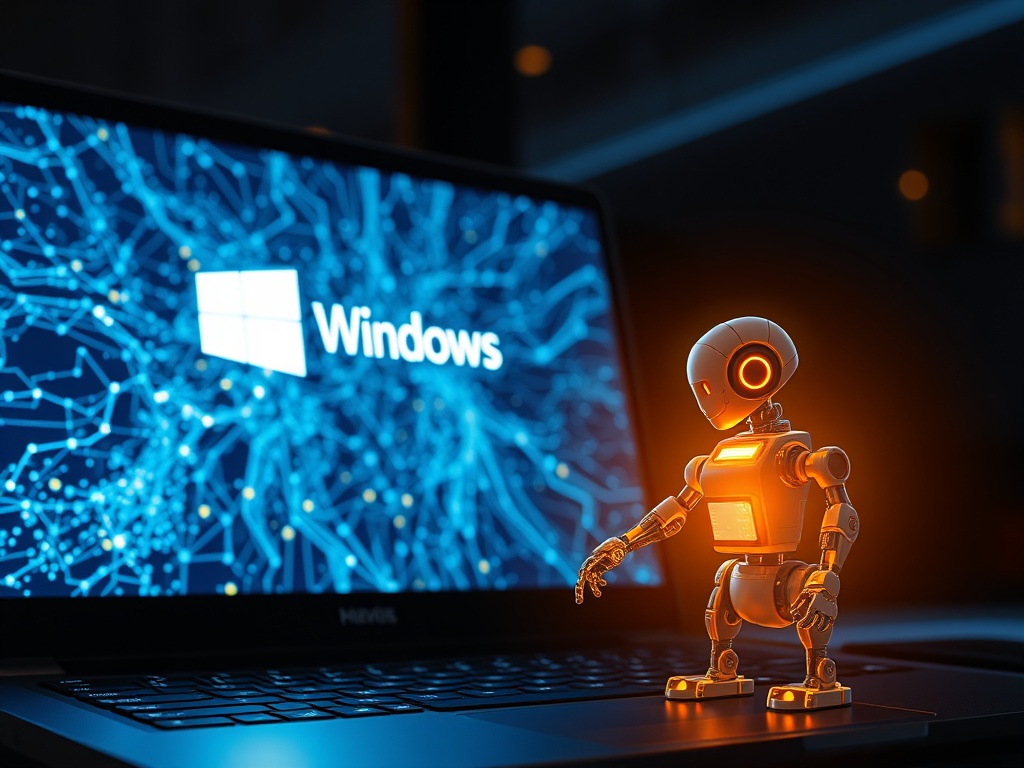BitcoinWorld

OpenAI Model Unleashed: Microsoft Brings Revolutionary AI to Windows Users
In the rapidly evolving landscape of artificial intelligence, where innovation often dictates the future of technology and even the digital economy, a significant development is set to empower millions of users. For those keenly observing the intersection of cutting-edge AI and mainstream computing, Microsoft’s latest move to integrate OpenAI’s new free and open GPT model, gpt-oss-20b, directly into Windows 11 is nothing short of revolutionary. This isn’t just about another AI tool; it’s about democratizing advanced AI capabilities, making them accessible right on your personal computer and potentially influencing how we interact with digital assets and decentralized applications.
Microsoft AI: Bringing Cutting-Edge Models to Your Desktop
Microsoft is making a bold statement about the future of personal computing by bringing OpenAI’s gpt-oss-20b to Windows 11 users through its Windows AI Foundry platform. This strategic move underscores Microsoft’s commitment to embedding powerful Microsoft AI capabilities directly into its flagship operating system. Windows AI Foundry is designed to be a hub where users can tap into advanced AI features, APIs, and popular open-source models without needing complex cloud infrastructures. By integrating this compact yet powerful OpenAI Model, Microsoft is paving the way for a new era of on-device intelligence, allowing for more responsive and private AI experiences.
This initiative aligns with the broader trend of decentralizing AI processing, a concept familiar to the crypto community through decentralized AI projects. While not directly blockchain-related, bringing AI models to local machines reduces reliance on centralized servers, offering enhanced privacy and efficiency. It’s a step towards empowering individual users with sophisticated AI, much like how decentralized finance aims to empower individuals with financial tools.
Demystifying the Lightweight Powerhouse: What is GPT-OSS-20B?
At the heart of this announcement is the gpt-oss-20b model itself. OpenAI describes this new offering as “tool-savvy and lightweight,” a combination that makes it exceptionally versatile. Unlike larger, more resource-intensive models, GPT-OSS-20B is specifically optimized for “agentic tasks” like code execution and tool use. This means it excels at scenarios where an AI needs to interact with external systems or perform complex, multi-step operations. Here’s a quick overview of its key characteristics:
- Lightweight Design: Optimized for efficiency, allowing it to run on a wide range of consumer Windows hardware.
- Agentic Capabilities: Designed for tasks requiring interaction with tools, such as web search, Python code execution, or integrating with software workflows.
- Hardware Requirements: Capable of running on consumer PCs and laptops equipped with at least 16GB of VRAM, typically found in modern Nvidia or Radeon GPUs.
- Training Methodology: Trained using high-compute reinforcement learning, which enhances its ability to power AI agents and call external tools effectively.
- Text-Only: Currently processes and generates only text, meaning it does not handle images or audio.
This model’s ability to run efficiently on consumer hardware is a significant breakthrough. It means developers and everyday users can experiment with advanced AI without needing to invest in enterprise-grade computing resources or rely solely on cloud services, making sophisticated Microsoft AI more accessible than ever.
Unlocking Potential: How AI Agents Redefine Personal Computing
The true power of gpt-oss-20b lies in its potential to power autonomous AI Agents. Imagine a digital assistant that can not only understand your requests but also execute complex tasks across various applications, write code, or even manage your digital workflow. This model is built for exactly that. Microsoft emphasizes its suitability for:
- Building Autonomous Assistants: Creating intelligent companions that can proactively assist with tasks, schedule appointments, or manage information.
- Embedding AI into Real-World Workflows: Integrating AI capabilities directly into existing software, from office applications to specialized industry tools.
- Bandwidth-Constrained Environments: Its lightweight nature ensures efficient operation even in areas with limited internet connectivity, as much of the processing can happen locally.
This shift towards local AI processing enhances user privacy and reduces latency, making AI interactions smoother and more secure. The ability to deploy powerful AI Agents directly on a user’s machine opens up new possibilities for personalization and efficiency that were previously confined to cloud-based services.
Beyond Windows: The Expanding Reach of This OpenAI Model
While the initial focus is on Windows 11, Microsoft has confirmed plans to expand the availability of this remarkable OpenAI Model. macOS users can anticipate its arrival soon, further broadening its reach across major operating systems. This cross-platform availability signifies a commitment to making advanced AI tools universally accessible. Beyond individual devices, both gpt-oss-20b and its larger counterpart, gpt-oss-120b, are also being made available through major cloud platforms:
- Microsoft Azure AI Foundry: Microsoft’s hosted AI platform provides a robust environment for developers and enterprises to leverage these models at scale.
- Amazon Web Services (AWS): The availability on AWS further solidifies its position as a widely accessible and deployable AI solution for a broad developer ecosystem.
This multi-platform strategy ensures that developers and businesses, regardless of their preferred ecosystem, can integrate this powerful OpenAI Model into their applications and services. This widespread deployment will accelerate innovation across various sectors, from software development to data analysis.
What’s Next for Windows AI and the Future of On-Device Intelligence?
Despite its impressive capabilities, the gpt-oss-20b model does come with certain limitations, notably its text-only nature and a reported tendency to hallucinate. OpenAI’s in-house benchmark, PersonQA, revealed that gpt-oss-20b hallucinated in response to 53% of questions about people, indicating areas for future improvement in factual accuracy. This highlights the ongoing challenge in AI development to balance capability with reliability.
However, the broader implications for Windows AI are profound. This move represents a significant step towards a future where AI is not just a cloud service but an integral, pervasive component of our everyday computing experience. It empowers developers to build more intelligent applications that can run offline, respect user privacy, and deliver real-time insights. As AI models become more efficient and hardware continues to advance, we can expect to see even more sophisticated AI capabilities migrating from the cloud to our devices, transforming how we work, learn, and interact with technology.
Conclusion
Microsoft’s decision to bring OpenAI’s gpt-oss-20b directly to Windows 11 users is a pivotal moment in the evolution of personal computing. By democratizing access to a lightweight, tool-savvy OpenAI Model, Microsoft is not only enhancing the capabilities of Windows but also fostering a new generation of on-device AI Agents. While challenges like hallucination rates persist, the potential for innovation in localized, efficient AI is immense. This development signals a future where powerful Microsoft AI and Windows AI are seamlessly integrated into our daily digital lives, promising a more intelligent, responsive, and personalized computing experience for everyone.
To learn more about the latest AI market trends, explore our article on key developments shaping AI models and their features.
This post OpenAI Model Unleashed: Microsoft Brings Revolutionary AI to Windows Users first appeared on BitcoinWorld and is written by Editorial Team





